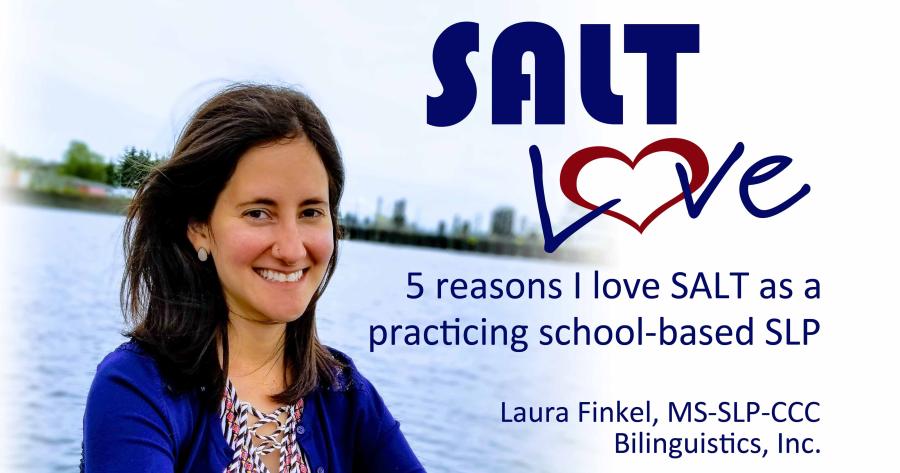
5 reasons I love SALT as a practicing school-based SLP

5 reasons I love SALT as a practicing school-based SLP
Published at: 2019-09-18
First and foremost, I have to say thank you to my very dear friend Mari Bliss. Mari and I carpooled to and from work 4-5 days a week for 2 hours a day. Mari challenged me personally and professionally, taught me and all of the district SLPs how to use SALT, and she advocated for the purchase of SALT for bilingual speech language pathologists in my district. If it weren’t for her, I wouldn’t be writing this post nor would have found my other love of my life, which is SALT. She patiently heard me out, while I resisted her “tedious, impossible, time-consuming, and unrealistic” language sampling ways. That’s right, I wasn’t always a SALT believer or even a language sampler (I’m quite embarrassed to admit that last part). Unfortunately, it took me 5 years to buy into this functional and lovely tool. 1. What do you do with a language sample?!?! Often times, after transcribing a 3-minute language sample, I didn’t know what I was looking for. I knew there were ways to calculate type token ratio, vocabulary diversity, subordination index and rate of speech, but I hadn't done that by hand since college. SALT calculates all of that for you and more. Not only does it provide a beautiful standards report chart comparing the student’s language sample to other children their age, but it has also taught me to recognize patterns in language samples that I never noticed before. One of those patterns, which I get so many referrals from teachers for, but never knew how to describe it, is mazing. Check this free SALT course out if you want to learn more about mazes. Mazes are any filled pauses, false starts, repetitions, or revisions. This tremendously helped me work with my students with language organization and executive functioning difficulties. 2. I see the fruits of my labor! Last school year, I worked with a 4th grade student on sentence combining 30 minutes a week for the whole year. You know that moment when you’re like, am I even doing anything? You know what I’m talking about. Right after spring break, when summer feels so far away, you begin to question everything in your life. Anyway, when I compared the student’s SALT subordination index to the previous year’s SALT she improved! The performance report indicated that she went from a subordination index of 1 to 1.4. Her language complexity increased quite a bit during story retells. Woot! I did notice that her type token ratio hadn't improved since we didn't work on vocabulary, so picking a goal wasn’t too hard. She needed support in improving her framework for learning new vocabulary. 3. Don’t even get me started on the performance report. What? SALT generates reports? Yes. You heard me. After you transcribe and code your language sample, you click on a button and it writes a report about the findings of the language sample. Mari tried to tell me for two years that SALT would save me time, but I had to experience it on my own to understand that 1) just like any new test, it takes more time at first, but then it gets easier and 2) When you consider how long it takes to administer a battery of language testing, score it and write about it, SALT saves so. much. time. 4. My goals are much more specific and functional. Don’t get me wrong, I love a good wh-question goal, but ever since I started using the narrative scoring scheme to write literacy macrostructure goals, I’m more inclined to frequently progress monitor. Language is on a continuum, so rubrics help measure receptive and expressive language in a comprehensive way. Even when a standardized test aligned with converging evidence that accurately identified children with language impairment, I often had trouble coming up with functional communication goals based on a battery of language tests. I didn’t want to teach to the test, but I wanted my students to communicate more effectively and someday graduate from speech/language services. In depth language sampling gives me a baseline to formulate specific, individualized and functional goals. 5. I enjoy my job more. Bottom line is, I was in a bit of an SLP funk so to speak. I felt like I was writing the same goals over and over again for different students. I now enjoy evaluations, progress monitoring, goal writing, IEP meetings and let’s face it, that’s at least half, if not more of our job as school-based speech-language pathologists. The therapy is more enjoyable because I love my students’ goals and I see where I want them to be communicating in a year. So, thanks to Mari and her patience and SALT and its brilliance, I’ll happily be a school-based speech language pathologist for years to come. I hope I can pass my love of this amazing software on to other SLPs. Whether your straight out of graduate school or a seasoned SLP and wanting to freshen up your skills, I hope you find something to re-energize yourself as SALT did for me. Your dearest-SALT-loving SLP, Laura Finkel, MS-SLP-CCC
Laura Finkel, MS-SLP-CCC is a bilingual speech language pathologist at Bilinguistics. She specializes in school-based teacher and parent centered speech language pathology, students from diverse backgrounds and Augmentative and Alternative Communication (AAC).
No Comments yet. Be the first to comment.